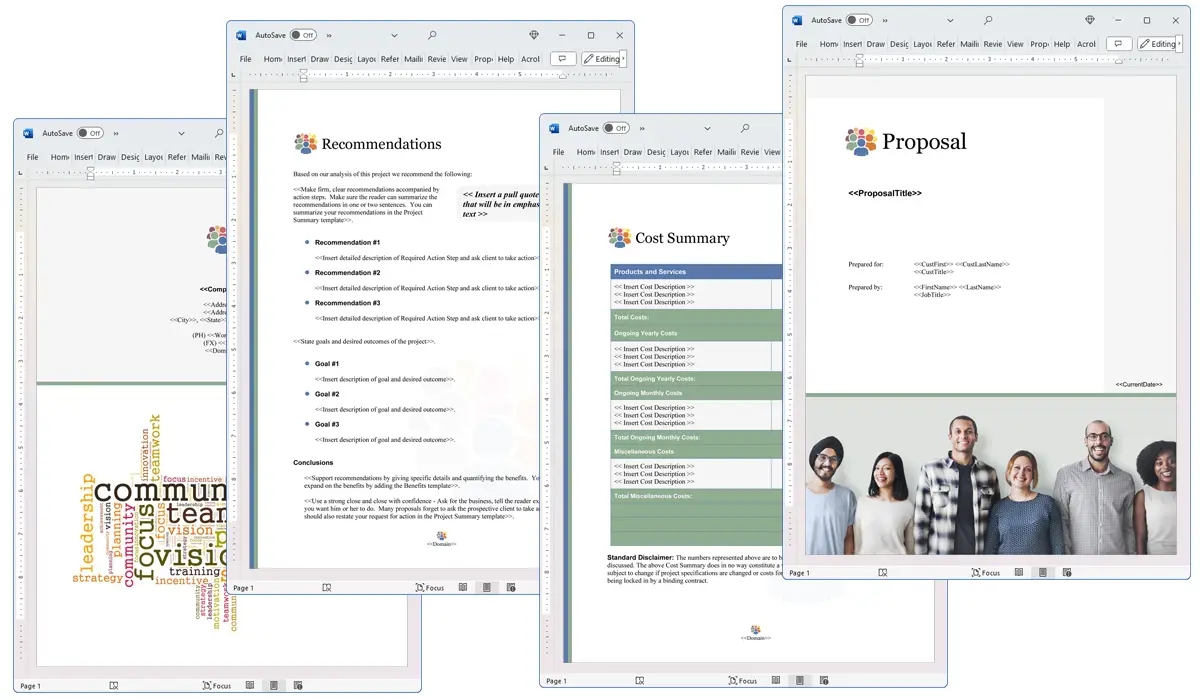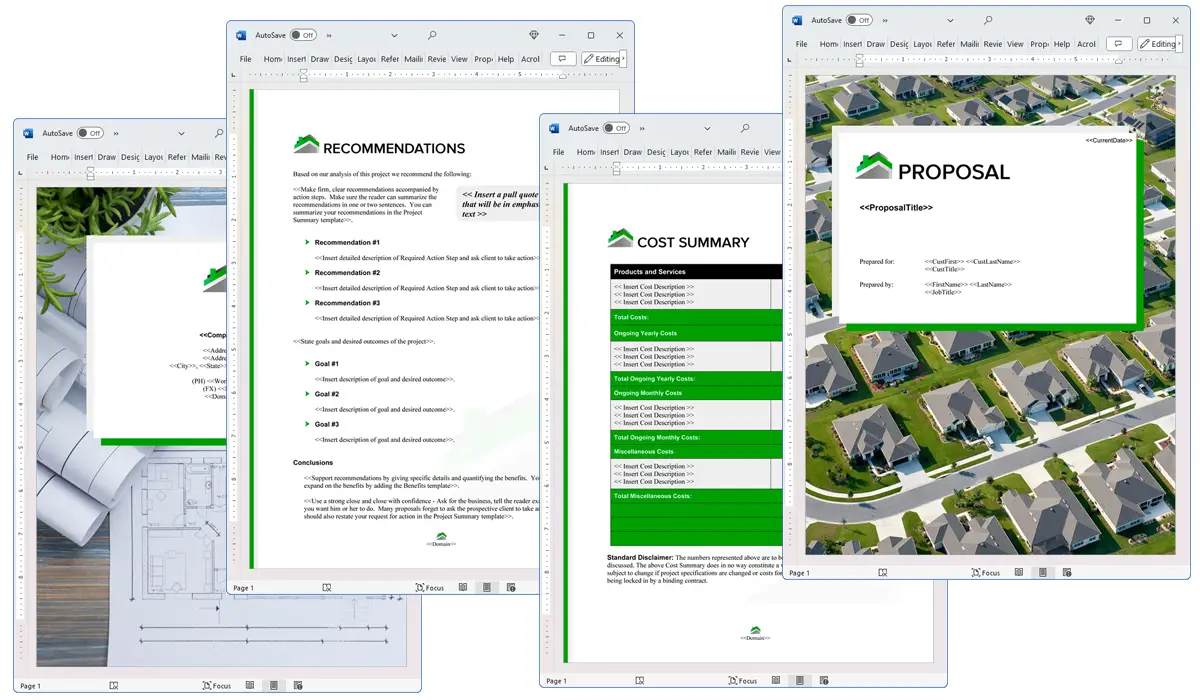What is the Downtime chapter used for?
Proposal Kit Professional Bundle adds more design themes, all six Contract Packs,
a project management library, and Expert Edition software.

Illustration of Proposal Pack Community #1
We include this Downtime chapter template in every Proposal Pack, along with thousands more. You assemble this chapter with others in various combinations to create custom-tailored business proposals, plans, reports, and other documents. Proposal Packs apply custom visual designs to the templates, giving the final documents a consistent professional finish.
 DOWNLOADABLE, ONE-TIME COST, NO SUBSCRIPTION FEES
DOWNLOADABLE, ONE-TIME COST, NO SUBSCRIPTION FEES
Overview of the Downtime Chapter
The Downtime chapter is an important component used in the construction of business proposal documents, particularly when addressing technical services or products. This chapter helps to outline and clarify the expected or experienced offline periods that could affect business operations, which is a significant consideration for anyone reliant on continuous service or production. Understanding downtime is crucial, as it can impact decision-making, risk assessment, and contract negotiations in a business environment.
How is the Downtime Chapter Used?
When used in a business proposal, the Downtime chapter is used to present information about how much offline time can be expected from a technical service or product, or the historical data of such occurrences. It serves as a reassurance or a point of reality-check for potential clients, highlighting the reliability or the improvement areas of the service being proposed. For service providers, it's a section to showcase their commitment to uptime and their strategies for minimizing downtime.
What is Included in the Downtime Chapter?
The Downtime chapter typically includes:
- An introduction to the concept of downtime as it relates to the specific service or product offered.
- Historical data on the provider's past downtimes, which helps establish credibility and transparency.
- A detailed explanation of policies regarding downtime, including prevention strategies and how unexpected downtimes are handled.
- Specifications or expectations of downtime that align with industry standards or client requirements, often seen in responses to RFPs (Request for Proposals).
- Any guarantees or compensations offered should the agreed upon downtime limits be exceeded.
Use Case Examples for the Downtime Chapter
- Web Services: Describing the uptime reliability of hosting services and the impact of potential downtimes on businesses.
- IT Services: Outlining downtime incidents in managed IT services and detailing recovery plans.
- Software Development: Providing details on maintenance schedules that may cause downtime in software applications.
- Hardware Suppliers: Specifying the reliability and repair times for hardware components.
- Technical Support Services: Explaining the average response time and resolution time that leads to system downtime.
- Automation Systems: Describing how automated systems handle downtime and their back-up processes.
- Manufacturing and Fabrication: Detailing the impact of machine downtime on production lines.
- RFP Responses: Stating compliance with minimum downtime requirements as specified in client RFP documents.
- General Information: Providing general policies on operational downtimes for various technical services.
- Technical Consultancy: For consultants offering insights into reducing and managing downtime in technology-dependent environments.
Key Takeaways
- The Downtime chapter is important for outlining expected or historical downtime in technical business proposals.
- It enhances transparency and establishes trust by detailing past downtime incidents and future downtime policies.
- This chapter is and can be adapted to different industries and services, making it crucial for proposals involving technical, manufacturing, or IT services.
- Including a Downtime chapter helps businesses manage expectations and demonstrate their commitment to minimizing operational disruptions.
- It plays a significant role in RFP responses, where meeting downtime criteria can be a deciding factor in winning contracts.

Illustration of Proposal Pack Global #5
 What Our Clients Say
What Our Clients SayI have been a long time user of Proposal Pack and Proposal Pack Wizard. The combination of the content in the proposal pack and the automation the proposal pack wizard provides saves me so much time so I can focus on my business. The ability to utilize the verbiage that comes with proposal pack saves me days of time not having to recreate the wheel. The wizard makes it so much easier to manage the entire proposal process, it would be mistake not to use them both together."
 4.7 stars, based on 845 reviews
4.7 stars, based on 845 reviewsRelated Chapters

The Downtime chapter and other chapters are integrated into a Word document as illustrated here in the Proposal Pack Real Estate #6 design theme. There are hundreds of design themes available, and every design theme includes the Downtime chapter template.
A proper business proposal will include multiple chapters. This chapter is just one of many you can build into your proposal. We include the complete fill-in-the-blank template in our Proposal Pack template collections. We also include a library of sample proposals illustrating how companies in different industries, both large and small, have written proposals using our Proposal Packs. This template will show you how to write the Downtime.
We include a chapter library for you to build from based on your needs. All proposals are different and have different needs and goals. Pick the chapters from our collection and organize them as needed for your proposal.
Using the Proposal Pack template library, you can create any business proposal, report, study, plan, or document.
 Ian Lauder has been helping businesses write their proposals and contracts for two decades. Ian is the owner and founder of Proposal Kit, one of the original sources of business proposal and contract software products started in 1997.
Ian Lauder has been helping businesses write their proposals and contracts for two decades. Ian is the owner and founder of Proposal Kit, one of the original sources of business proposal and contract software products started in 1997.By Ian Lauder
 Published by Proposal Kit, Inc.
Published by Proposal Kit, Inc.


 Cart
Cart
 Facebook
Facebook YouTube
YouTube X
X Search Site
Search Site